Abstract
Child of agriculture families are likely to be exposed to agricultural chemicals, even if they are not involved in farm activities. This study was designed to determine whether such children are exposed to higher levels of pesticides than children whose parents are not involved in agriculture and whose homes are not close to farms. Household dust and soil samples were collected in children's play areas from 59 residences in eastern Washington State (26 farming, 22 farmworker, and 11 nonfarming families). The majority of the farm families lived within 200 feet of an operating apple or pear orchard, whereas all reference homes were located at least a quarter of a mile from an orchard. Four organophosphorous (OP) insecticides commonly used on tree fruit were targeted for analysis: azinphosmethyl, chlorpyrifos, parathion, and phosmet. Samples were extracted and analyzed by gas chromatography/mass selective detection. Pesticide concentrations in household dust were significantly higher than in soil for all groups. OP levels for farmer/farm-worker families ranged from nondetectable to 930 ng/g in soil (0.93 ppm) and from nondetectable to 17,000 ng/g in dust (17 ppm); all four OP compounds were found in 62% of household dust samples, and two-thirds of the farm homes contained at least one OP above 1000 ng/g. Residues were found less frequently in reference homes and all levels were below 1000 ng/g. Household dust concentrations for all four target compounds were significantly lower in reference homes when compared to farmer/farmworker homes (Mann Whitney, U test; p < 0.05). These results demonstrate that children of agricultural families have a higher potential for exposure to OP pesticides than children of nonfarm families in this region. Measurable residues of a toxicity, I compound registered exclusively for agricultural use, azcnphosmettyl were found in household dust samples from all study homes, suggesting that low level exposure to such chemicals occurs throughout the region. Children's total and cumulative exposure to this pesticide class from household dust, soil, and other sources warrants further investigation.
Full text
PDF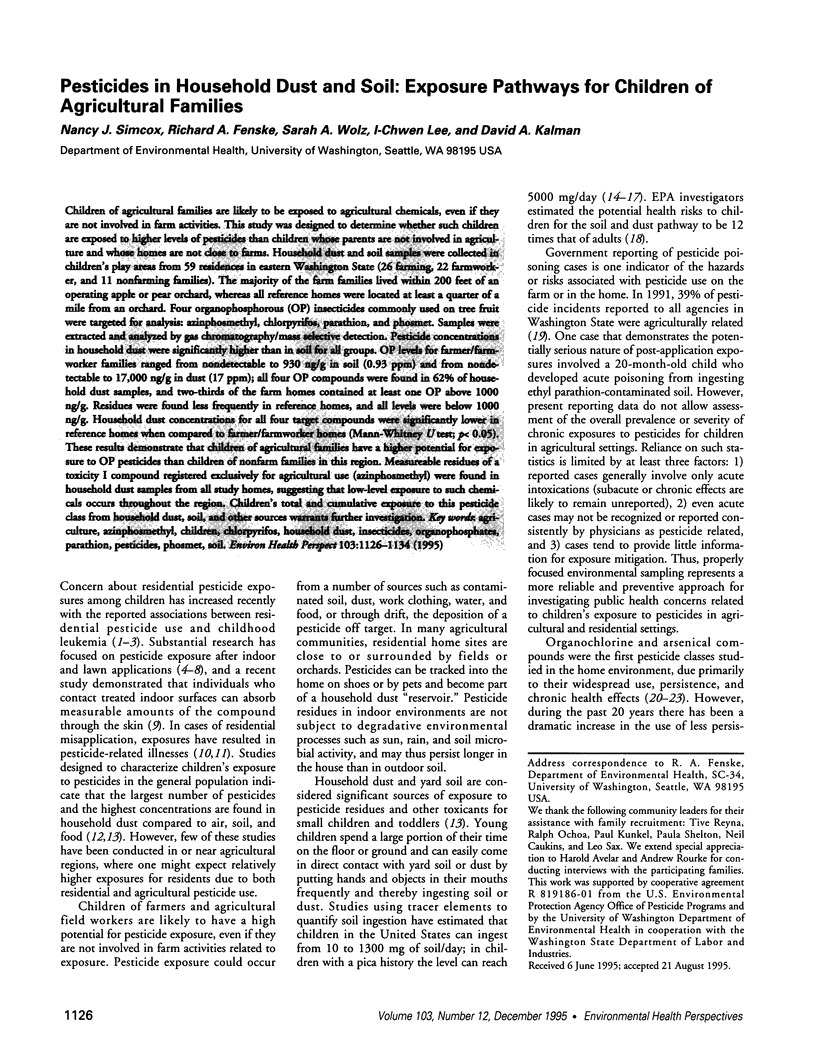
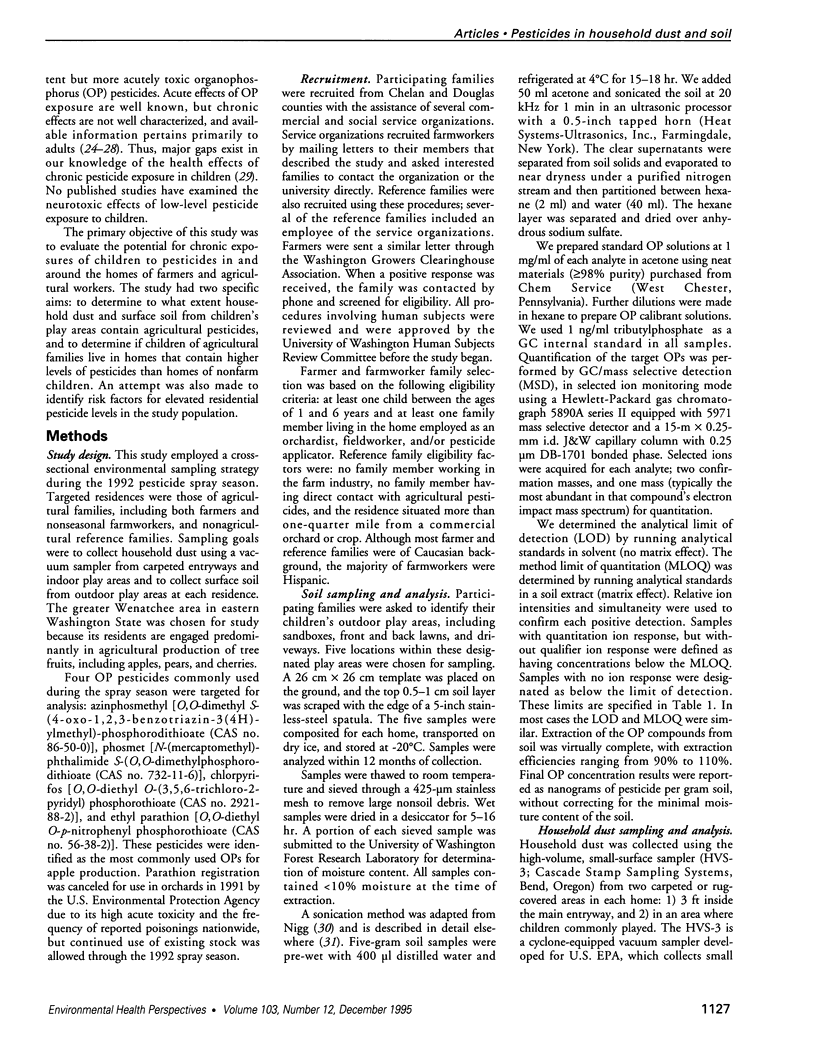
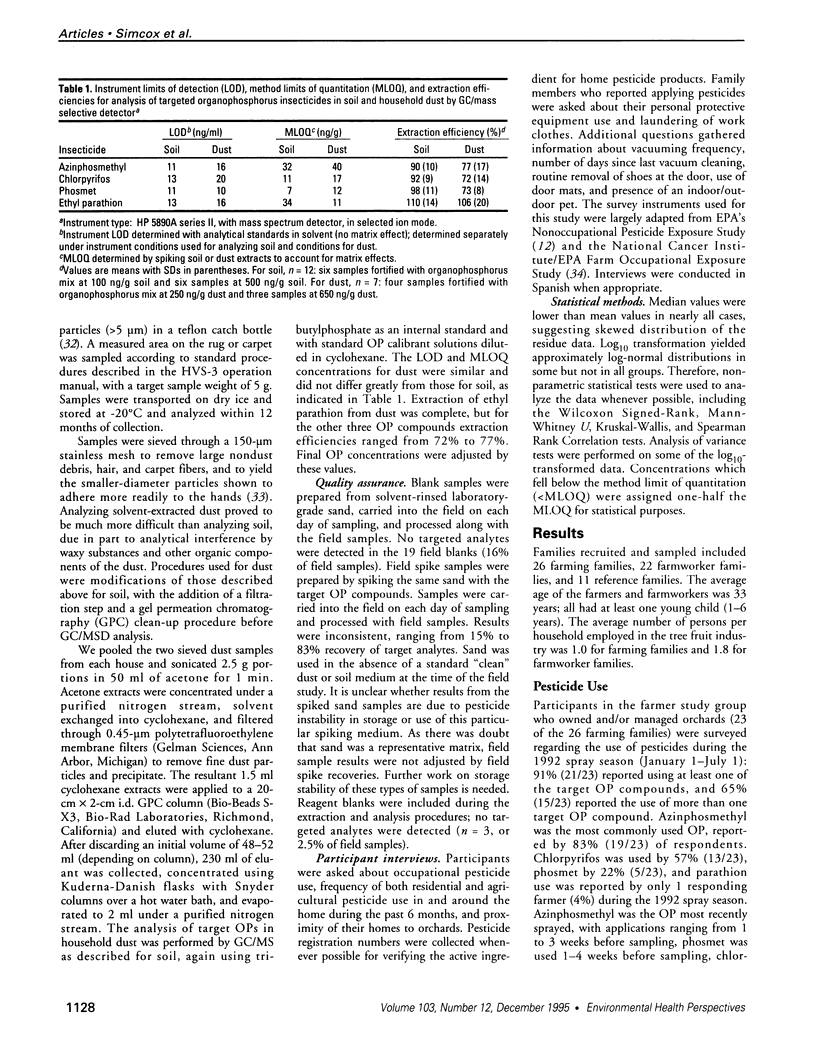

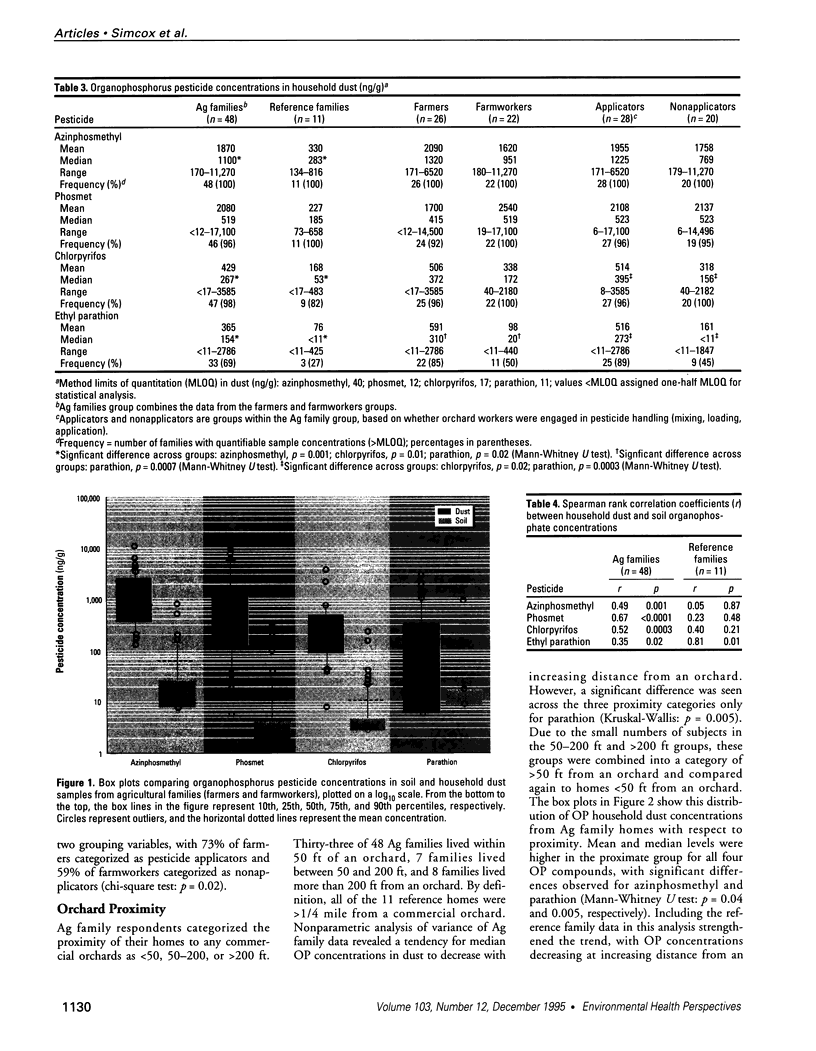
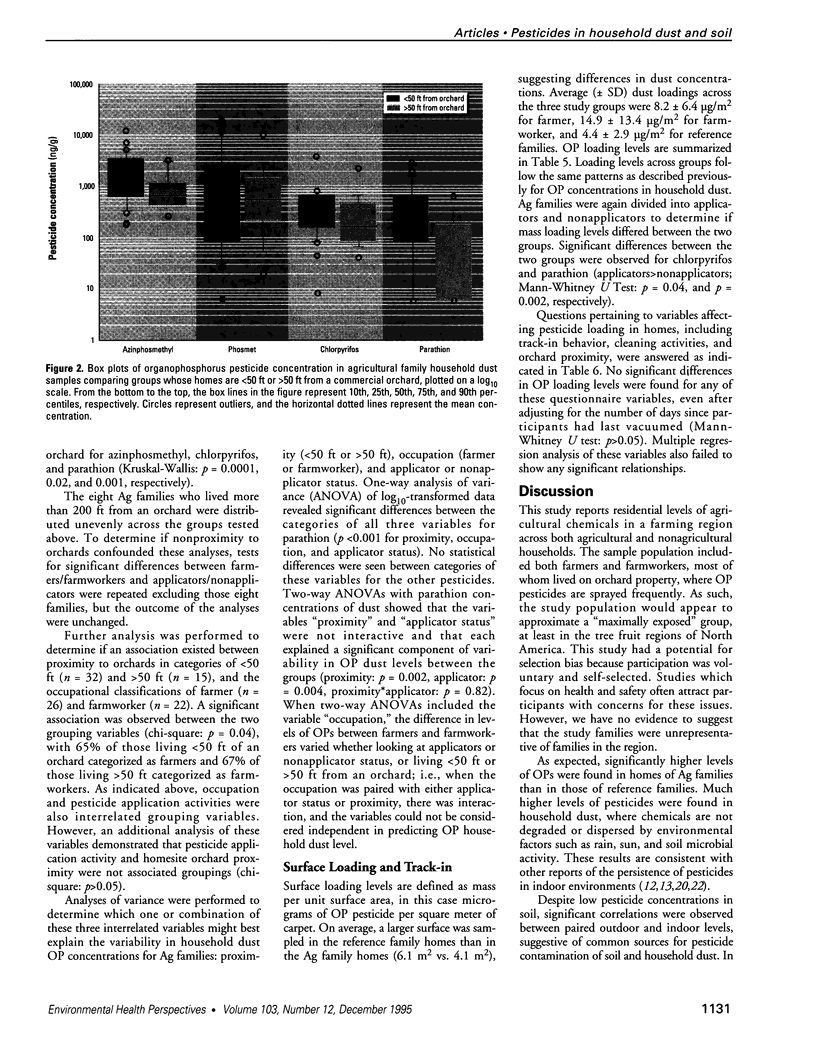
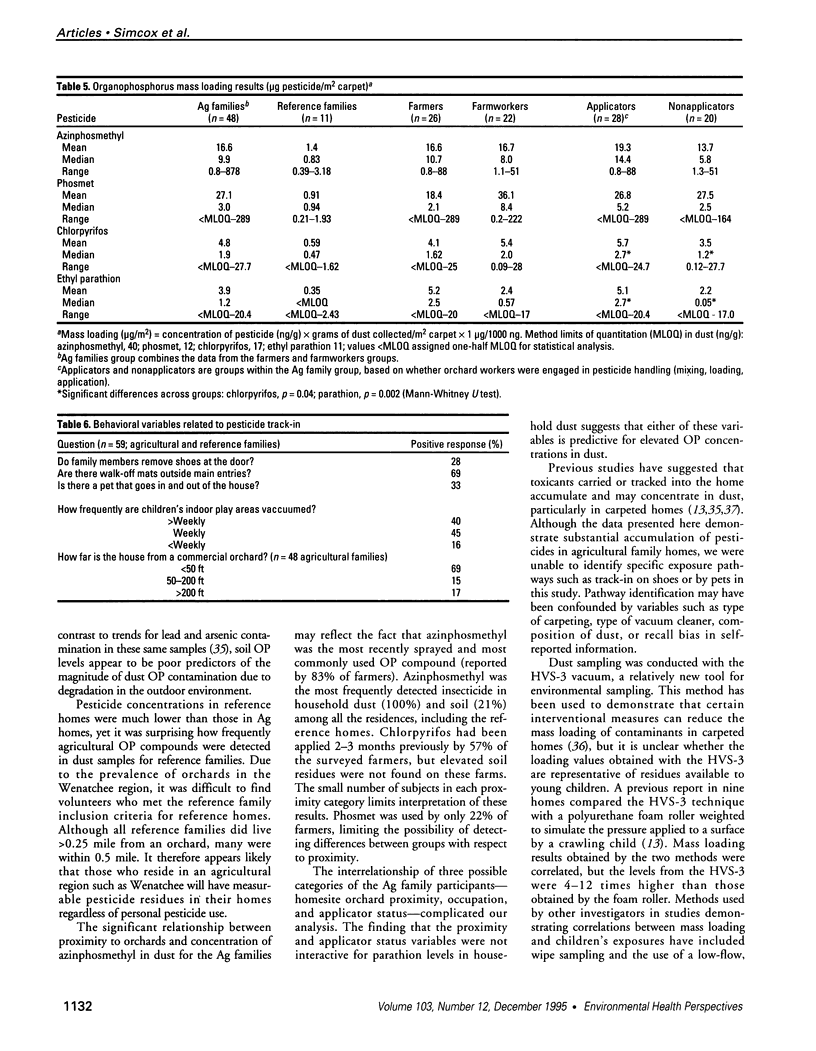

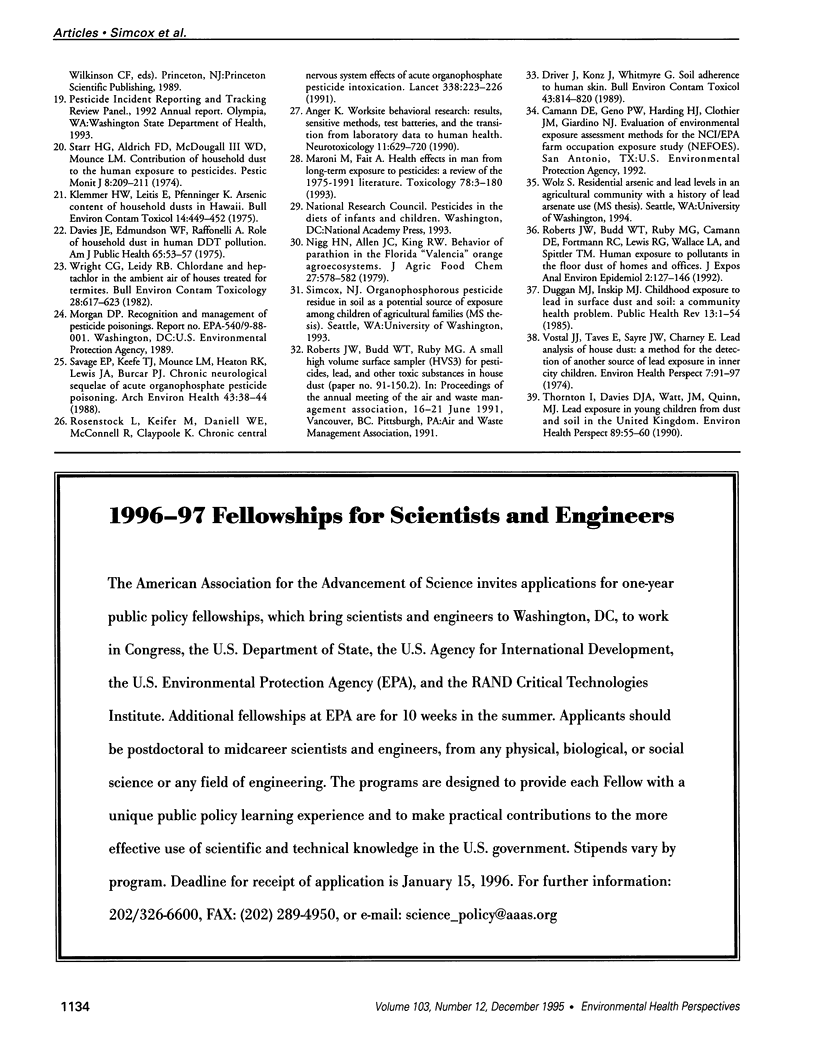
Images in this article
Selected References
These references are in PubMed. This may not be the complete list of references from this article.
- Binder S., Sokal D., Maughan D. Estimating soil ingestion: the use of tracer elements in estimating the amount of soil ingested by young children. Arch Environ Health. 1986 Nov-Dec;41(6):341–345. doi: 10.1080/00039896.1986.9935776. [DOI] [PubMed] [Google Scholar]
- Buckley J. D., Robison L. L., Swotinsky R., Garabrant D. H., LeBeau M., Manchester P., Nesbit M. E., Odom L., Peters J. M., Woods W. G. Occupational exposures of parents of children with acute nonlymphocytic leukemia: a report from the Childrens Cancer Study Group. Cancer Res. 1989 Jul 15;49(14):4030–4037. [PubMed] [Google Scholar]
- Calabrese E. J., Barnes R., Stanek E. J., 3rd, Pastides H., Gilbert C. E., Veneman P., Wang X. R., Lasztity A., Kostecki P. T. How much soil do young children ingest: an epidemiologic study. Regul Toxicol Pharmacol. 1989 Oct;10(2):123–137. doi: 10.1016/0273-2300(89)90019-6. [DOI] [PubMed] [Google Scholar]
- Calabrese E. J., Stanek E. J., 3rd A guide to interpreting soil ingestion studies. II. Qualitative and quantitative evidence of soil ingestion. Regul Toxicol Pharmacol. 1991 Jun;13(3):278–292. doi: 10.1016/0273-2300(91)90068-7. [DOI] [PubMed] [Google Scholar]
- Davies J. E., Edmundson W. F., Raffonelli A. The role of house dust in human DDT pollution. Am J Public Health. 1975 Jan;65(1):53–57. doi: 10.2105/ajph.65.1.53. [DOI] [PMC free article] [PubMed] [Google Scholar]
- Davis S., Waller P., Buschbom R., Ballou J., White P. Quantitative estimates of soil ingestion in normal children between the ages of 2 and 7 years: population-based estimates using aluminum, silicon, and titanium as soil tracer elements. Arch Environ Health. 1990 Mar-Apr;45(2):112–122. doi: 10.1080/00039896.1990.9935935. [DOI] [PubMed] [Google Scholar]
- Driver J. H., Konz J. J., Whitmyre G. K. Soil adherence to human skin. Bull Environ Contam Toxicol. 1989 Dec;43(6):814–820. doi: 10.1007/BF01702049. [DOI] [PubMed] [Google Scholar]
- Duggan M. J., Inskip M. J. Childhood exposure to lead in surface dust and soil: a community health problem. Public Health Rev. 1985;13(1-2):1–54. [PubMed] [Google Scholar]
- Fenske R. A., Black K. G., Elkner K. P., Lee C. L., Methner M. M., Soto R. Potential exposure and health risks of infants following indoor residential pesticide applications. Am J Public Health. 1990 Jun;80(6):689–693. doi: 10.2105/ajph.80.6.689. [DOI] [PMC free article] [PubMed] [Google Scholar]
- Klemmer H. W., Leitis E., Pfenninger K. Arsenic content of house dusts in Hawaii. Bull Environ Contam Toxicol. 1975 Oct;14(4):449–452. doi: 10.1007/BF01705511. [DOI] [PubMed] [Google Scholar]
- Lowengart R. A., Peters J. M., Cicioni C., Buckley J., Bernstein L., Preston-Martin S., Rappaport E. Childhood leukemia and parents' occupational and home exposures. J Natl Cancer Inst. 1987 Jul;79(1):39–46. [PubMed] [Google Scholar]
- Maroni M., Fait A. Health effects in man from long-term exposure to pesticides. A review of the 1975-1991 literature. Toxicology. 1993 Mar;78(1-3):1–180. doi: 10.1016/0300-483x(93)90227-j. [DOI] [PubMed] [Google Scholar]
- Nigg H. N., Allen J. C., King R. W. Behavior of parathion residues in the Florida "Valencia" orange agroecosystem. J Agric Food Chem. 1979 May-Jun;27(3):578–582. doi: 10.1021/jf60223a041. [DOI] [PubMed] [Google Scholar]
- Richter E. D., Kowalski M., Leventhal A., Grauer F., Marzouk J., Brenner S., Shkolnik I., Lerman S., Zahavi H., Bashari A. Illness and excretion of organophosphate metabolites four months after household pest extermination. Arch Environ Health. 1992 Mar-Apr;47(2):135–138. doi: 10.1080/00039896.1992.10118767. [DOI] [PubMed] [Google Scholar]
- Rosenstock L., Keifer M., Daniell W. E., McConnell R., Claypoole K. Chronic central nervous system effects of acute organophosphate pesticide intoxication. The Pesticide Health Effects Study Group. Lancet. 1991 Jul 27;338(8761):223–227. doi: 10.1016/0140-6736(91)90356-t. [DOI] [PubMed] [Google Scholar]
- Savage E. P., Keefe T. J., Mounce L. M., Heaton R. K., Lewis J. A., Burcar P. J. Chronic neurological sequelae of acute organophosphate pesticide poisoning. Arch Environ Health. 1988 Jan-Feb;43(1):38–45. doi: 10.1080/00039896.1988.9934372. [DOI] [PubMed] [Google Scholar]
- Shu X. O., Gao Y. T., Brinton L. A., Linet M. S., Tu J. T., Zheng W., Fraumeni J. F., Jr A population-based case-control study of childhood leukemia in Shanghai. Cancer. 1988 Aug 1;62(3):635–644. doi: 10.1002/1097-0142(19880801)62:3<635::aid-cncr2820620332>3.0.co;2-3. [DOI] [PubMed] [Google Scholar]
- Starr H. G., Jr, Aldrich F. D., MacDougall W. D., 3rd, Mounce L. M. Contribution of household dust to the human exposure to pesticides. Pestic Monit J. 1974 Dec;8(3):209–212. [PubMed] [Google Scholar]
- Thornton I., Davies D. J., Watt J. M., Quinn M. J. Lead exposure in young children from dust and soil in the United Kingdom. Environ Health Perspect. 1990 Nov;89:55–60. doi: 10.1289/ehp.908955. [DOI] [PMC free article] [PubMed] [Google Scholar]
- Vostal J. J., Taves F., Sayre J. W., Charney E. Lead analysis of house dust: a method for the detection of another source of lead exposure in inner city children. Environ Health Perspect. 1974 May;7:91–97. doi: 10.1289/ehp.74791. [DOI] [PMC free article] [PubMed] [Google Scholar]
- Wagner S. L., Orwick D. L. Chronic organophosphate exposure associated with transient hypertonia in an infant. Pediatrics. 1994 Jul;94(1):94–97. [PubMed] [Google Scholar]
- Wright C. G., Leidy R. B. Chlordane and heptachlor in the ambient air of houses treated for termites. Bull Environ Contam Toxicol. 1982 May;28(5):617–623. doi: 10.1007/BF01605594. [DOI] [PubMed] [Google Scholar]




